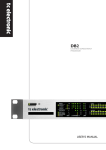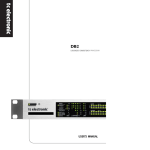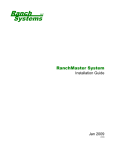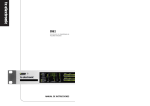Download USER`S MANUAL - American Musical Supply
Transcript
RH450 USER’S MANUAL 1 2 3 4 5 6 7 8 9 10 11 12 Read these instructions. Keep these instructions. Heed all warnings. Follow all instructions. Do not use this apparatus near water. Clean only with dry cloth. Do not block any ventilation openings. Install in accordance with the manufacturer’s instructions. Do not install near heat sources such as radiators, heat registers, stoves, or other apparatus (including amplifiers) that produce heat. Do not defeat the safety purpose of the polarized or grounding-type plug. A polarized plug has two blades with one wider than the other. A grounding type plug has two blades and a third grounding prong. The wide blade or the third prong are provided for your safety. If the provided plug does not fit into your outlet, consult an electrician for replacement of the obsolete outlet. Protect the power cord from being walked on or pinched particularly at plugs, convenience receptacles, and the point where they exit from the apparatus. Only use attachments/accessories specified by the manufacturer. Use only with the cart, stand, tripod, bracket, or table specified by the manufacturer, or sold with the apparatus. When a cart is used, use caution when moving the cart/apparatus combination to avoid injury from tip-over. 13 Unplug this apparatus during lightning storms or when unused for long periods of time. 14 Refer all servicing to qualified service personnel. Servicing is required when the apparatus has been damaged in any way, such as power supply cord or plug is damaged, liquid has been spilled or objects have fallen into the apparatus, the apparatus has been exposed to rain or moisture, does not operate normally, or has been dropped. Warning! • To reduce the risk of fire or electrical shock, do not expose this equipment to dripping or splashing and ensure that no objects filled with liquids, such as vases, are placed on the equipment. • This apparatus must be earthed. • Use a three wire grounding type line cord like the one supplied with the product. • Be advised that different operating voltages require the use of different types of line cord and attachment plugs. • Check the voltage in your area and use the correct type. Please refer to the following table: • • • • • Voltage Line plug according to standard 110-125V UL817 and CSA C22.2 no 42. 220-230V CEE 7 page VII, SR section 107-2-D1/IEC 83 page C4. 240V BS 1363 of 1984. Specification for 13A fused plugs and switched and unswitched socket outlets. This equipment should be installed near the socket outlet and disconnection of the device should be easily accessible. To completely disconnect from AC mains, disconnect the power supply cord from the AC receptacle. The mains plug of the power supply shall remain readily operable. Do not install in a confined space. Do not open the unit – risk of electric shock inside. Caution: You are cautioned that any change or modifications not expressly approved in this manual could void your authority to operate this equipment. Service • There are no user-serviceable parts inside. • All service must be performed by qualified personnel. a EN IMPORTANT SAFETY INSTRUCTIONS EMC / EMI & CERTIFICATE OF CONFORMITY EMC/EMI This equipment has been tested and found to comply with the limits for a Class B Digital device, pursuant to part 15 of the FCC rules. These limits are designed to provide reasonable protection against harmful interference in residential installations. This equipment generates, uses and can radiate radio frequency energy and, if not installed and used in accordance with the instructions, may cause harmful interference to radio communications. However, there is no guarantee that interference will not occur in a particular installation. If this equipment does cause harmful interference to radio or television reception, which can be determined by turning the equipment off and on, the user is encouraged to try to correct the interference by one or more of the following measures: • • • • Reorient or relocate the receiving antenna. Increase the separation between the equipment and receiver. Connect the equipment into an outlet on a circuit different from that to which the receiver is connected. Consult the dealer or an experienced radio/TV technician for help. For Customers in Canada: This Class B digital apparatus complies with Canadian ICES-003. Cet appareil numérique de la classe B est conforme à la norme NMB-003 du Canada. Certificate of Conformity TC Electronic A/S, Sindalsvej 34, 8240 Risskov, Denmark, hereby declares on own responsibility that the following product: RH450 – Bass amplifier that is covered by this certificate and marked with CE-label conforms with following standards: EN 60065 Safety requirements for mains operated (IEC 60065) electronic and related apparatus for household and similar general use EN 55103-1 Product family standard for audio, video, audio-visual and entertainment lighting control apparatus for professional use. Part 1: Emission. EN 55103-2 Product family standard for audio, video, audio-visual and entertainment lighting control apparatus for professional use. Part 2: Immunity. With reference to regulations in following directives: 73/23/EEC, 89/336/EEC Issued in Risskov, January 2009 Anders Faurskov Chief Executive Officer b TABLE OF CONTENTS INTRODUCTION EN Important Safety Instructions & Certificate of Conformity . . . . . . . . . . . . . . . . . . .a-b Table of Contents . . . . . . . . . . . . . . . . . . . . . . . . . . . .3 Introduction . . . . . . . . . . . . . . . . . . . . . . . . . . . . . . . .4 Quick Setup Guide . . . . . . . . . . . . . . . . . . . . . . . . . . .5 OPERATION Front panel . . . . . . . . . . . . . . . . . . . . . . . . . . . . . . . . .6 RC4 . . . . . . . . . . . . . . . . . . . . . . . . . . . . . . . . . . . . .13 Rear panel . . . . . . . . . . . . . . . . . . . . . . . . . . . . . . . .14 APPENDIX General Protection mode . . . . . . . . . . . . . . . . . . . . .17 Heat Protection mode . . . . . . . . . . . . . . . . . . . . . . .17 Technical Specifications . . . . . . . . . . . . . . . . . . . . . .19 3 INTRODUCTION Congratulations on the purchase of your new RH450 amp! When it comes to designing revolutionary products, TC Electronic is used to ripping up the rulebook. After three decades of doing just that in the guitar, studio and desktop music making markets – and designing many award-winning and revolutionary products along the way – we have now applied this considerable expertise to the bass market. The result is the new RH450 bass head, RS210/212 cabinets and REMOTE RC4 that combine to deliver an incredible bass rig, designed without compromise. RH450 is loud and proud but also hides extraordinary technology behind its traditional fascia. TC Electronic has a long heritage of designing amps and, with its Active Power Management™, has effectively designed an amp that gives you all the character of a tube amp while delivering 450 Watts of undiluted power. RH450 has traditional tone controls but also includes groundbreaking features giving the amp a personality and sound all of its own. TubeTone™ emulates all of the characteristics of a traditional tube circuit to deliver an unparalleled and rich playing experience, while SpectraComp™ gives you the best in studio quality compression for a live situation. With its “per string” compression, SpectraComp™ delivers more bite and punch than any other compressor in any other bass amp system. Ultimate flexibility, ultimate portability – RH450 is the ideal amp for the studio, road and rehearsal room. The compact 450 Watt Class D amplifier design makes it easy to take anywhere and get great results, fast – no matter what the situation. With three on-board user memories you can quickly swap sounds or instruments mid gig – an instant solution if you want to recall your favorite sonic combinations or if you take more than one bass guitar with you on the road. And talking of the touring musician, RH450’s Auto-sensing PSU means that you can plug and play safely in whatever country you find yourself in – no fuse changing necessary. Finally a system that delivers everything that you need and more in a single amp. Please note: We reserve the rights to change the contents of this manual at any time. The latest manual revision can always be downloaded from www.tcelectronic.com. If you need additional information and support, be sure to visit TC Support Interactive – this service can also be accessed via www.tcelectronic.com. 4 QUICK SETUP GUIDE Unpacking • Unpack your RH450 amp. • The box should contain the following items: – RH450 amplifier – Power Cable – RCA to mini jack cable – Manual • Inspect all items for signs of transit damage. In the unlikely event of this having occurred, inform the carrier and supplier. • Keep all the packaging if damage has occurred, as this will show evidence of excessive handling force. • It is also a good idea to keep the packaging for future transportation. Setting up • Connect the Speaker Out jack of the amplifier to your cabinet using a speaker cable. Both Speakon and ¼" jack cables can be used. RS cabinets come with a speaker cable included, so if you have bought a RS cabinet, you are all set to go. • You can connect up to three RS cabinets or any other two 8 Ohm cabinets of another brand to the amplifier. (minimum load: 4 Ohm). • • • • • Connect the power cable and power up. The RH450’s power supply accepts voltages from 100 to 240 VAC. Connect your bass to the input jack on the front panel. Adjust the input gain using the GAIN knob. Adjust the output volume using the MASTER knob. Play! EN If you just can’t wait… Here are a few quick steps to get you playing within minutes Accessories The following items can be purchased at your music dealer: • RS210 and RS212 cabinets. • RC4: A pedal with four footswitches that can use to switch between three memory locations and also to mute for tuning purposes. This pedal also shows tuner information. • 19" bracket that allows you to mount the amplifier in a standard 19" rack. • Soft bags for both the RH450 amplifier and the RC4. • Flight cases for the RH450 amplifier and the RC4. • Flight cases for both RS cabinet models. Be sure to check www.tcelectronic.com for latest news about these and other TC products. 5 OPERATION – FRONT PANEL Front Panel 1 – INPUT You can connect an active or passive bass to this ¼" input jack. The RH450 input stage is designed to adapt to any type of pickup. 2+3 – GAIN & OVERLOAD LED The input gain should be set to the highest possible level without overloading the input stage. To find the correct setting, simply plug in your bass, play and turn up the GAIN knob until the OVERLOAD LED occasionally lights up. Then reduce the gain slightly. When set, simply turn up the MASTER volume knob to start playing. 2 – SPECTRACOMP™ (in Shift Mode) Press the SHIFT button. Then turn the knob to adjust the 6 amount of SpectraComp compression. SpectraComp™ uses a so-called spectral or multi-band approach to compression, allowing for individual compression of the low, mid and high frequency bands. Multiband compression allows a significantly smoother and more transparent compression without killing dynamics or tone. SpectraComp™ is an advanced compressor, optimized to get the best from a bass signal. If you simply want to hear it, press the SHIFT button and turn the knob while playing. If you want to know a bit more about what is going on behind the scenes, please read the section “SpectraComp In Depth” below. When you haven’t been using the RH450’s front panel controls for about twenty seconds, the LED will flash rapidly, and the RH450 will automatically return to normal mode. In normal mode, the GAIN knob controls the amplifier’s gain level. other words: You are constantly dealing with a tight and difficult compromise. SpectraComp In Depth Gain Reduction / Compression Meter When using SpectraComp™, the light-ring around the GAIN knob doubles as a compression meter, showing you how much compression is applied to the signal. With Spectral Compression, the RH450 amplifier uses a different approach that allows for independent compression of the Low, Mid and High frequency areas. This way, the right amount of compression is added to the individual strings of your bass, resulting in a smoother and much more transparent compression. Auto Make-up Gain As compression by nature reduces the loudest parts and peaks of the signal, you may feel that many conventional compressors “eat” the level of your signal, resulting in a lower output volume. SpectraComp™ automatically compensates for compression gain reduction, giving you an even output volume. Spectral Compression vs. Full Band Compression Virtually any compressor on the market for bass is based on a “full band” principle, meaning that the compressor will respond and compress identically across the full (20 Hz to 20 kHz) frequency range. From the low E (or B) string to the G string: The electric bass has a very wide dynamic range. When using standard compressors, the low E string will – due to its higher energy – control when and how the compressor responds to and shapes the entire signal. The typical result is that either the G string is not compressed at all or that – just when the G string starts to sound right –, the low E string is compressed too strongly. In 4 – TONE Controls The RH450 has four tone controls: Bass, Lo-mid, Hi-mid and Treble. These controls have been tuned carefully to address four relevant bass frequency areas, and should allow you to dial in your sound with ease. As you know, each instrument has its own sound characteristics. So if you feel that the RH450’s tone controls don’t grab exactly the frequencies your particular instrument requires, you can change the center frequencies of the four EQ bands. Changing Tone Control Frequency You can change the control frequencies of all four frequency bands. This is sometimes referred to as “parametric bands” or “sweepable”. Normally, the BASS, LO-MID, HI-MID and TREBLE knobs are used to set the gain of each EQ band. To change the center frequency of an EQ band, press the SHIFT button once and then adjust a band’s center frequency by turning its knob. 7 EN OPERATION – FRONT PANEL OPERATION – FRONT PANEL Example: Press SHIFT and turn the LO-MID knob to change the center frequency of that control. Sometimes “sweepable” tone controls can be a bit tedious to work with. Here is an easy step-by-step guide to adjusting RH450’s Low-mid band to your bass and setup: • • • • 8 Boost the LO-MID band – the more you boost, the easier it is to find the right frequency. Hit the SHIFT button to get access to the center frequency of the EQ bands. Now, while playing your bass, slowly turn the LO-MID knob to sweep the low-mid frequency across the frequency range. When you find the frequency that you prefer to control, simply hit the SHIFT button again to switch back to gain control and set the right amount of low-mid gain. While the RH450 is in Shift mode, the SHIFT button will be blinking to remind you that you are in Shift mode. When you haven’t been using the RH450’s front panel controls for about twenty seconds, the LED will flash rapidly, and the RH450 will automatically return to normal mode. Gain and Frequency Ranges 71 Hz to 1120 Hz (default: 280) Bass Freq range: -24 dB to +15 dB Bass Gain range: (Shelving type) Low Mid Freq range: Low Mid Gain range: (Fixed 2.1 oct.) 100 Hz to 1600 Hz (default: 400) -24 dB to +15 dB High Mid Freq range: High Mid Gain range: (Fixed 2.1 oct.) 200 Hz to 3150 Hz (default: 800) -24 dB to +15 dB Treble Freq range: Treble Gain range: (Shelving type) 400 Hz to 6300 Hz (default: 1600) -24 dB to +12 dB 5 – TUBETONE™ Tubetone™ allows you to alter the “personality” and sound of your RH450. The effects you can achieve range from a small touch of classic tube amp response and character through obvious, but pleasant “tube attitude” to highly overdriven. Contrary to many tube simulations, Tubetone™ recreates both the entire preamp section (located before the tone control section) and the power amp section (located after the tone controls). Not only does this give you the most realistic and flexible recreation of the actual tube sound and response, but it also allows you to alter the behavior and character of Tubetone™ through the RH450 tone controls as you would on an actual tube amp. 5 – PRESET LEVEL (in Shift Mode) Press SHIFT and then turn the TUBETONE knob to adjust the level of the currently selected MEM/preset. When you haven’t been using the RH450’s front panel controls for about twenty seconds, the LED will flash rapidly, and the RH450 will automatically return to normal mode. In normal mode, the TUBETONE knob controls the intensity of the Tubetone™ effect. Range: -12 dB to 0 dB 6 – MASTER Use the MASTER level knob to set the overall output level of the amp. The master level also controls the level of the headphone output. 7 – PHONES This is a ¼" connector for headphones. Our studio quality headphone amp – with a mild speaker filter added to the bass sound – caters for great sound in the headphones. The headphone output also plays back any signal connected to the AUX IN (“Rehearsal”) input jack found on the rear panel of the RH450. This feature allows you to play along with e.g. an MP3 player (e.g. an iPod®), a signal from a computer soundcard or any other audio source playing background tracks – excellent for rehearsing or checking out new tracks without disturbing the neighbors. The TUBETONE knob adjusts the amount of both the preamp and the power-amp tube simulation. Notice that the RH450 works equally well with or without a speaker cabinet connected. 9 EN OPERATION – FRONT PANEL OPERATION – FRONT PANEL The headphone volume is controlled by the MASTER level knob. When a set of headphones is connected to the PHONES jack, the speaker output on the rear panel of the RH450 is disabled. This is a very convenient feature when you want to use a “silent mode” at night: There is no need to disconnect the speaker cabinet. In order to set the right level balance between the Auxiliary input signal and your bass sound, use the preset level feature. Level settings are stored as a part of RH450 MEM’s. 8 – MUTE The MUTE button not only mutes the speaker and headphones outputs, but also the balanced output. This means that you can tune up with no sound going to your own rig or to the PA. 9 – SHIFT The SHIFT button is used to access the secondary functions marked with red text on the RH450’s front panel. The following controls have secondary functions: Normal mode GAIN EQ (1-4) TUBETONE Shift mode (press SHIFT) SpectraComp Depth EQ Bands Center Frequencies Preset/Memory Level Settings When you haven’t been using the RH450’s front panel controls for about twenty seconds, the RH450 will return to normal mode, 10 where the knobs control the primary functions printed in white. 10 – MEM 1/2/3 The RH450 features three user memories which allow you to effortlessly store and recall your favorite settings. Storing settings is extremely simple: – Dial in the settings that you like – Press and hold one of the MEM buttons for circa two seconds. – When the MEM button blink, your settings have been stored. – To recall a MEM-setting, simply press the corresponding MEM button once. What is stored? Any parameter that is operated by a light ring knob is stored. This means the settings of all front panel controls – apart from the Master level, the SHIFT and MUTE buttons – are stored. Why MEM-settings? Even though a lot of bass players tend to play with the same sound most of the time, a lot of players do have a couple of different basses, playing styles, pickup settings or other factors that requires amp settings to be changed. We figured that it would be handy to simply push one button instead of fiddling with several knobs. Remote Control RH450’s optional remote control – “RC4” – allows for floor recall of all three MEM-settings as well as mute and tuner display. information. To activate Mute mode, simply press the MUTE button. Now the BASS tone control turns into a high resolution pitch indicator supporting the Note and Arrow field of the tuner. 11 – TUNER RH450 is equipped with a fully chromatic, high accuracy bass tuner. The tuner is always active, whether the RH450 is in Mute mode or not. Here is how you read the display: The played note is shown on the left side of the display. Too low – tune up On the right side of the display, – a circle indicates that the note is in tune. – an arrow pointing right indicates that the note is too low and should be tuned up. – an arrow pointing left indicates that the note is too high and should be tuned down. Too low – tune up Too high – tune down In tune Sharp notes: C#, D#, F#, G# and A# are indicated as follows: Too high – tune down In tune Tuner information is also displayed in the optional RC4 footswitch. Yes, this is correct: If you have a RC4 footswitch, you do no longer need a separate tuner. Please refer to the manual section “RC4” to learn more about the footswitch. Tuner Reference The RH450’s default tuner reference is 440 Hz, like with any other tuner. However, you can select any reference frequency between 438 and 445 Hz. This is how you select the tuner reference frequency: – If the RH450 is switched on, switch it off. – Press and hold the MUTE button during power up. Example – A# The tuner also offers a Mute mode with additional tuner 11 EN OPERATION – FRONT PANEL OPERATION – FRONT PANEL – The RH450 now powers up in Tuner reference mode, which is illustrated by an “R” in the Display (see illustration below). Tune Reference mode – Dial the BASS tone control to alter the tuner reference. The center position equals 440 Hz, and each LED represents one Hertz. So to set the tuner reference frequency e.g. to 438 Hz, turn the BASS knob counter-clockwise until the second LED on the left lights up. – Press the MUTE button to exit Tuner Reference mode. 12 Please note that the tuner’s reference frequency is remembered even after powering the unit off. EN RC4 The optional RC4 footswitch not only allows you to remote access the RH450’s three memory locations (MEM 1/2/3), but also to mute the signal for silent tuning and even view the tuner information. No power-supply is needed for the RC4 as it receives its power from the RH450 amp. 1 – Memory Switches 1, 2 and 3 Press one of the three numbered buttons to recall the settings stored in the associated MEM-location. A green light ring around the switch indicates that this MEM-setting has been recalled (activated). – Note that you can only recall a MEM-setting if a setting has actually been stored in a memory location. – Also note that as soon as you change one of the stored settings on the RH450 front panel, the green light ring on the footswitch will be unlit. This indicates that the positions of the front panel knobs no longer correspond with the stored settings. 2 – MUTE button Press the M(ute) button to mute the RH450’s outputs. This is useful for tuning or e.g. unplugging/changing your bass. The MUTE button also mutes the RH450’s balanced output, allowing you to tune silently, even when connected to the PA system. 3 – DISPLAY The display always indicates tuner information in a couple of different ways. The detected note is shown on the left side. On the right side of the display, a circle indicates that the note is in tune, an arrow pointing to the right indicates that the note should be tuned up, and an arrow pointing to the left indicates that the note should be tuned down. In addition to these indications (that are also shown on the RH450 tuner display), a line of nine dots below the display indicates how far from the target pitch the currently played note is. When only the center dot is lit, the note is in tune. Too low – tune up Too high – tune down In tune 13 OPERATION – REAR PANEL Rear Panel 1 – MAINS IN – Power In & POWER switch The RH450’s auto-sensing switchmode power-supply accepts any mains voltage from 90 to 240 volts – you do not have to change settings, fuses or anything else. Simply connect a standard IEC three pin connector to the local mains voltage, and you are up and running. This is particularly handy when you use the RH450 on a tour. The ground pin of the PSU must be connected in order to avoid voltage differences between e.g. the PA and the RH450. 2 – SPEAKER OUT Use the SPEAKER OUT combo connector for connecting the RH450 to your cabinet(s). You can use a speaker cable with either Speakon or ¼" jacks. Do NOT use instrument cables! 14 The RH450 can be used to drive any cabinet combination of up to three RS 210/212 units, or any other cabinet combination with a 4 Ohm minimum load. OPERATION – REAR PANEL The RC4 4 – DIGITAL OUT Use the DIGITAL OUT jack to connect the RH450’s digital output stage directly to a digital audio device, such as a computer’s audio interface. This way, you can record your bass sound straight into Pro Tools, Logic or any other DAW application. The digital output signal is in 96 kHz/24 bit AES/EBU format. This ensures the highest possible resolution and quality of your recorded bass signal. To determine where in the signal chain the signal for the digital output should be tapped, use the PRE/POST switch located right beside the LINE DRIVER OUT jack on the RH450’s rear panel. Your bass signal is present on both Left and Right digital channel. – – Set your DAW to follow (slave to) “external clock”. Hit the record button in your DAW and start playing. SPDIF Compatibility While a simple XLR to RCA converter may suffice to allow recording through an SPDIF interface, please note that AES/ EBU and SPDIF have different level and impedance specifications, which in some cases can cause compatibility problems. If you want to record with an analog signal instead, you may also use the RH450’s balanced output signal from the LINE DRIVER OUT jack. 5 – AUX IN Rehearse – Stereo Rehearsal Auxiliary Input Any signal present on the stereo AUX IN jacks is played back through the PHONES output on the front of the RH450. This allows you to play along with a rehearsal track when checking out new stuff or to practice to a beat or just a metronome click. The included “Mini jack to RCA” cable allows you to use iPod®, iPhone® or any other consumer playback device as a source for rehearsing. Setting up for recording: In order to record straight from the RH450’s digital output, follow these steps: – Connect the RH450’s DIGITAL OUT jack to your DAW. 15 EN 3 – REMOTE IN Use the REMOTE IN jack to connect the RH450 to the optional footswitch-remote “RC4”. The RC4 gives you access to the three memory locations, the mute function, and has tuner indication as well. OPERATION – REAR PANEL In order to set the right level balance between the Auxiliary input signal and your bass sound, use the preset level feature. Level settings are stored as a part of RH450 MEM-settings. 6 + 7 – INSERT PREAMP I/O – Effects Loop/Break point These jacks provide a break point between the RH450’s preamp section (which includes SpectraComp™, Tone controls and the TubeTone™ module) and the power amp section. This break point can be used as a regular serial effects loop for inserting e.g. modulation effects or other external devices. Linking Two Amps The break point may also be used to link two RH450 units together to achieve even more power. – Use a standard ¼" jack instrument cable to connect the first RH450 PRE-AMP OUT (the upper) to the second RH450’s POWER-AMP IN (the lower jack). – Plug your bass into the INPUT jack on the first RH450 and adjust your sound using the controls on this RH450. – Set the volume using the MASTER volume knobs of both amps. You now have tons of amplification power at your fingertips! 16 8 – LINE DRIVER OUT – Balanced Line Out Use the LINE DRIVER OUT jack to connect the RH450 to the PA when you play on stage or to connect your amp to a recording device when you are in the studio. To determine where in the signal chain the signal for the balanced output should be tapped, use the PRE/POST switch located right beside the LINE DRIVER OUT jack. The RH450’s MUTE button mutes the balanced output (as well as the speaker and headphones outputs). This means that you can tune up with no sound going to your own rig or to the PA. The RH450’s balanced output has been designed with the utmost care for the sound. This is achieved through a galvanic isolated transformer coupling. The active design by far out performs most standard DI boxes around, and it is capable of driving long cable hauls. No phantom power is required. Ventilation Be sure not to cover the black cooling plate of the RH! Insufficient ventilation may cause the amplifier’s temperature to increase. If the RH450 is insufficiently ventilated, it may go into Heat Protection mode, which is indicated by an “H” on the front panel display. Introduction The RH450 is equipped with an intelligent protection system, ensuring that the amp does not suffer or malfunction if operated wrongly or in extreme environments. General Protection mode If the RH450’s display indicates “P”, the amp is in Protection mode. Protection mode is invoked if for some reason a short-circuit situation occurs. In Protection mode, the speaker outputs are shut off so that the speakers cannot be damaged by a shortcut.The balanced output, digital recording out and the effects loop, however, are still passing audio in Protection mode. To remedy the problem, try turning off the RH450 for a minute and then turn it on again. If the display still indicates “P”, you will have to send the RH450 to a qualified service-center for inspection. Heat Protection Mode If the display indicates an “H”, the amp is too hot. This is rarely seen, but a few extreme situations can invoke this mode: a) If the amplifier is used in an environment that is too hot, or if proper ventilation is not ensured. b) Cabinets or combinations of cabinets must load the amplifier with a minimum of 4 Ohm. A maximum of three RS cabinets can be used or two 8 Ohm cabinets of any other brand. If e.g. the speaker output is loaded with only 2 Ohm or less and you drive the RH450 at very high volumes over a long period of time, the amplifier enters Heat Protection mode. In – – – – both situations, proceed as follows: Turn off the amplifier. Solve the issues. Allow the amplifier to cool off for a few minutes. Turn on the amplifier again. 17 EN APPENDIX – MISCELLANEOUS APPENDIX – SIGNAL FLOW 18 APPENDIX – TECHNICAL SPECIFICATIONS Tone controls Bass Low Mid High Mid Treble 1/4" jack 1 Mohm / 100 pF -96 to 32dB Center Freq: 280Hz (range: 71-1120Hz, Gain: +15/-24dB) Center Freq: 400Hz (range: 100-1600Hz, Gain: +15/-24dB) Center Freq: 800Hz (range: 200-3150Hz, Gain: +15/-24dB) Center Freq: 1600Hz (range: 400-6300Hz, Gain: +12/-24dB) Mains supply Universal 100 - 240V 50/60Hz (80w @ 1/8 Power) Speaker out Combined Speakon / 1/4" jack Power rating 450w (800w Peak) Balanced output Max. Output Optimal Load Impedance Transformer Balanced XLR, Pre/Post Pre-amp +0dBu Preamp out 1/4" Jack, Balanced Output, Max Output Level = +8dBu 1/4" Jack, balanced input, impedance = 10 kOhm, Max Input Level = +8dBu Power amp in 600 Ohm Tube Tone 0 to12, Tube amp Recreation Spectra Comp 3 band Spectral Compression Rehearsal input RCA, Left/Right input, fits to iPod ® Preset Level -12 dB to 0 gain attenuation Digital Recording out Balanced XLR, AES/EBU, (24-bit) User Memories 3 memory locations storing all front panel controls except Mute & Master Level Remote connection 5 pin DIN, Cable with shield Dimensions 275 x 290 x 66 mm / 10,8” x 11,4” x 2,6” Weight 4kg / 8.8 pounds Finish Sandblasted die-cast aluminum Tuner Tuning range Mute Master Level Headphone output Impedance Chromatic, constant on A0 (27.50Hz) to E5 (659.26Hz) EN Input Section Input connector Input impedance Gain range Mutes speaker out, Phones out and Balanced out Studio quality headphone amp 40 to 600 Ohm Due to continuous development, these specifications are subject to change without notice. 19







































